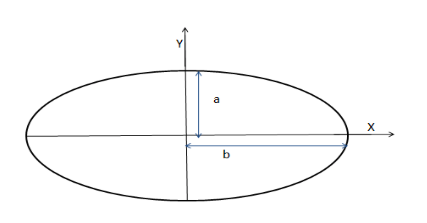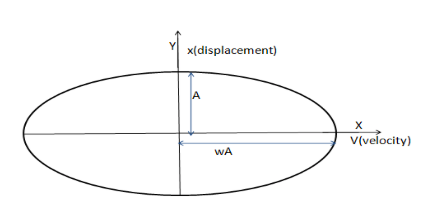
In case of simple harmonic motion, if the velocity is plotted along the X-axis and the displacement (from the equilibrium position) is plotted along the Y-axis, the resultant curve happens to be an ellipse with the ratio:
\[\dfrac{{majoraxis(alongX)}}{{\min oraxis(alongY)}} = 20\pi \]. What is the frequency of the simple harmonic motion?
A) \[\left( {\text{A}} \right){\text{ }}100Hz\]
B) \[\left( {\text{B}} \right){\text{ }}20Hz\]
C) \[\left( {\text{C}} \right){\text{ }}10Hz\]
D) \[\left( {\text{D}} \right){\text{ }}\dfrac{1}{{10}}Hz\]
Answer
568.5k+ views
Hint:First we have to assume the variables on the given data.
Then we defined the simple harmonic function and found the velocity by using the elliptical curve on the velocity displacement graph.
Finally we get the frequency of the simple harmonic function.
Complete step by step answer:
In case of Simple harmonic motion(S.M.H) be M,
Let $V$ is the velocity and displacement from equilibrium position is $x$ .
The displacement from equilibrium position is defined as a function of time $t$,
We can write it as,\[x = A\sin \omega t\].
Here, \[A\]= Amplitude of the S.H.M and \[\omega \]= Angular frequency = \[2\pi \times {\text{frequency}}\]
The velocity of the S.H.M is calculated by differentiating the displacement,
\[V = \dfrac{{dx}}{{dt}}\]=\[A\omega \cos \omega t\].
Now we know an elliptical equation in X-Y axis should be,
\[\dfrac{{{x^2}}}{{{a^2}}} + \dfrac{{{y^2}}}{{{b^2}}} = 1\] .
The elliptical equation diagram is as follows,

where, the major axis =\[2a\] and the minor axis = \[2b\].
Here, The velocity is plotted along X-axis and the displacement is plotted along Y-axis, and the resultant curve is an ellipse as the figure drawn is as follows:

Therefore, \[\dfrac{{{V^2}}}{{{A^2}{\omega ^2}}} + \dfrac{{{x^2}}}{{{A^2}}} = 1\] - Elliptical equation.
Here the major axis is $2\omega A$ and the minor axis is $2A$ .
In this question stated as, \[\dfrac{{majoraxis(alongX)}}{{\min oraxis(alongY)}} = 20\pi \]
Putting the values an we get,
\[ \Rightarrow \dfrac{{2\omega A}}{{2A}} = 20\pi \]
Cancelling the same term we get,
\[ \Rightarrow \omega = 20\pi \]
Now, we have to find out the frequency.
\[\omega = 2\pi \times {\text{frequency}}\]
\[ \Rightarrow \omega = 2\pi \times f\]
Let us take the \[f\] as LHS and remaining as in divide term we get
\[ \Rightarrow f = \dfrac{\omega }{{2\pi }}\]
Putting the value of \[\omega \]and we get,
\[ \Rightarrow f = \dfrac{{20\pi }}{{2\pi }}\]
On divide the term we get,
\[ \Rightarrow f = 10\]
Therefore the frequency is \[f = 10Hz\].
Hence, the right answer is in option (C).
Note: In the case of an S.H.M of a particle if the displacement from the equilibrium position is $x$,
Here \[\dfrac{{dx}}{{dt}}\] is the change in displacement per unit time which defines the Velocity of that particle.
If we represent the displacement as,\[x = A\sin \omega t\]
The velocity should be, \[V = \dfrac{{dx}}{{dt}} = \omega A\cos \omega t\]
\[ \Rightarrow V = \omega A\sin (\omega t + \dfrac{\pi }{2})\]
Hence, the phase difference between the displacement and velocity of a particle in S.H.M is \[\dfrac{\pi }{2}\].
Then we defined the simple harmonic function and found the velocity by using the elliptical curve on the velocity displacement graph.
Finally we get the frequency of the simple harmonic function.
Complete step by step answer:
In case of Simple harmonic motion(S.M.H) be M,
Let $V$ is the velocity and displacement from equilibrium position is $x$ .
The displacement from equilibrium position is defined as a function of time $t$,
We can write it as,\[x = A\sin \omega t\].
Here, \[A\]= Amplitude of the S.H.M and \[\omega \]= Angular frequency = \[2\pi \times {\text{frequency}}\]
The velocity of the S.H.M is calculated by differentiating the displacement,
\[V = \dfrac{{dx}}{{dt}}\]=\[A\omega \cos \omega t\].
Now we know an elliptical equation in X-Y axis should be,
\[\dfrac{{{x^2}}}{{{a^2}}} + \dfrac{{{y^2}}}{{{b^2}}} = 1\] .
The elliptical equation diagram is as follows,

where, the major axis =\[2a\] and the minor axis = \[2b\].
Here, The velocity is plotted along X-axis and the displacement is plotted along Y-axis, and the resultant curve is an ellipse as the figure drawn is as follows:

Therefore, \[\dfrac{{{V^2}}}{{{A^2}{\omega ^2}}} + \dfrac{{{x^2}}}{{{A^2}}} = 1\] - Elliptical equation.
Here the major axis is $2\omega A$ and the minor axis is $2A$ .
In this question stated as, \[\dfrac{{majoraxis(alongX)}}{{\min oraxis(alongY)}} = 20\pi \]
Putting the values an we get,
\[ \Rightarrow \dfrac{{2\omega A}}{{2A}} = 20\pi \]
Cancelling the same term we get,
\[ \Rightarrow \omega = 20\pi \]
Now, we have to find out the frequency.
\[\omega = 2\pi \times {\text{frequency}}\]
\[ \Rightarrow \omega = 2\pi \times f\]
Let us take the \[f\] as LHS and remaining as in divide term we get
\[ \Rightarrow f = \dfrac{\omega }{{2\pi }}\]
Putting the value of \[\omega \]and we get,
\[ \Rightarrow f = \dfrac{{20\pi }}{{2\pi }}\]
On divide the term we get,
\[ \Rightarrow f = 10\]
Therefore the frequency is \[f = 10Hz\].
Hence, the right answer is in option (C).
Note: In the case of an S.H.M of a particle if the displacement from the equilibrium position is $x$,
Here \[\dfrac{{dx}}{{dt}}\] is the change in displacement per unit time which defines the Velocity of that particle.
If we represent the displacement as,\[x = A\sin \omega t\]
The velocity should be, \[V = \dfrac{{dx}}{{dt}} = \omega A\cos \omega t\]
\[ \Rightarrow V = \omega A\sin (\omega t + \dfrac{\pi }{2})\]
Hence, the phase difference between the displacement and velocity of a particle in S.H.M is \[\dfrac{\pi }{2}\].
Recently Updated Pages
Master Class 12 Business Studies: Engaging Questions & Answers for Success

Master Class 12 Social Science: Engaging Questions & Answers for Success

Master Class 12 English: Engaging Questions & Answers for Success

Master Class 12 Chemistry: Engaging Questions & Answers for Success

Class 12 Question and Answer - Your Ultimate Solutions Guide

Master Class 12 Economics: Engaging Questions & Answers for Success

Trending doubts
What are the major means of transport Explain each class 12 social science CBSE

Which are the Top 10 Largest Countries of the World?

Draw a labelled sketch of the human eye class 12 physics CBSE

How much time does it take to bleed after eating p class 12 biology CBSE

Explain sex determination in humans with line diag class 12 biology CBSE

When was the first election held in India a 194748 class 12 sst CBSE




